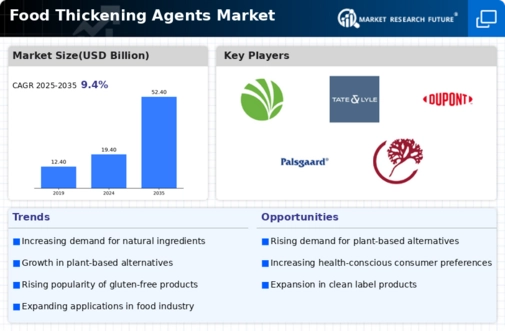Market Growth Projections
The Global Food Thickening Agents Market Industry is projected to experience substantial growth, with estimates indicating a rise from 19.4 USD Billion in 2024 to 52.4 USD Billion by 2035. This growth trajectory suggests a compound annual growth rate (CAGR) of 9.42% from 2025 to 2035, reflecting the increasing demand for thickening agents across various food applications. Factors such as rising consumer awareness, technological advancements, and expanding product offerings are likely to contribute to this growth. As the market evolves, stakeholders are expected to capitalize on emerging opportunities, fostering innovation and enhancing the competitive landscape.
Rising Demand for Processed Foods
The Global Food Thickening Agents Market Industry experiences a notable surge in demand for processed foods, driven by changing consumer lifestyles and preferences. As more individuals seek convenience in their meals, the use of thickening agents becomes essential in enhancing texture and stability. This trend is particularly evident in regions with busy urban lifestyles, where ready-to-eat meals are increasingly popular. The market is projected to reach 19.4 USD Billion in 2024, reflecting the growing reliance on processed food products. Consequently, manufacturers are likely to innovate and diversify their offerings to meet consumer expectations, further propelling the growth of thickening agents.
Regulatory Support for Food Safety
The Global Food Thickening Agents Market Industry benefits from regulatory support aimed at ensuring food safety and quality. Governments worldwide are implementing stringent regulations regarding food additives, which encourages manufacturers to adopt safe and approved thickening agents. This regulatory framework not only enhances consumer confidence but also drives market growth by promoting the use of compliant ingredients. As the industry adapts to these regulations, it is likely to witness an increase in the adoption of safe and effective thickening agents, contributing to the overall expansion of the market. The focus on food safety is expected to remain a priority, influencing product development and innovation.
Expanding Applications Across Food Segments
The Global Food Thickening Agents Market Industry is witnessing an expansion of applications across various food segments, including dairy, sauces, and bakery products. This diversification is driven by the need for improved texture and mouthfeel in a wide range of food products. For example, thickeners are crucial in creating creamy textures in dairy products and enhancing the viscosity of sauces. As consumer preferences evolve, manufacturers are likely to explore new applications for thickening agents, thereby broadening their market reach. This trend not only supports the growth of the industry but also encourages innovation in product formulations, catering to diverse consumer tastes and preferences.
Health Consciousness and Clean Label Trends
The Global Food Thickening Agents Market Industry is significantly influenced by the rising health consciousness among consumers. There is a marked shift towards clean label products, where consumers prefer natural and organic ingredients. This trend encourages food manufacturers to explore alternatives to synthetic thickeners, leading to a growing demand for natural thickeners such as guar gum and xanthan gum. As consumers become more discerning about food labels, the industry is adapting by incorporating these natural agents into their formulations. This shift not only aligns with consumer preferences but also enhances the market's potential for growth, as the demand for healthier food options continues to rise.
Technological Advancements in Food Processing
Technological advancements in food processing are reshaping the Global Food Thickening Agents Market Industry. Innovations in food technology enable manufacturers to develop more efficient and effective thickening agents that improve product quality and shelf life. For instance, advancements in hydrocolloid technology allow for the creation of thickeners that perform better at lower concentrations, thereby reducing costs and enhancing sustainability. These developments are likely to attract investment and drive market growth, as companies seek to optimize their production processes. As the industry evolves, the integration of these technologies may lead to a more competitive landscape, fostering innovation and expanding the range of available thickening agents.
















